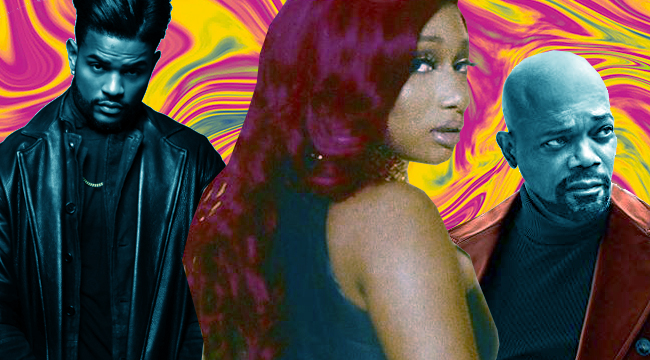
Long before rappers were gracing the screens of multiplexes and scoring executive producer credits in big-budget Hollywood comedies and thrillers, the primary way for Black people to see themselves on the big screen was as the villains or the victims. Occasionally, there’d be a mammy or a chauffeur or a stereotypical sidekick and that was pretty much it.
Then, in 1971, came two movies, Sweet Sweetback’s Baadasssss Song and the original Shaft, flipping the script (sorry) and inventing the Blaxploitation (Black exploitation) genre from whole cloth. For the first time, Black folks could see themselves as the heroes and drivers of the narratives playing in their local cinemas, and it wasn’t long before Hollywood realized the profit in giving them exactly what they wanted to see. These days, moviegoers can get that experience practically anytime they want, especially with the release of a new Shaft film this weekend featuring three generations of the titular heroes.
By the ‘80s though, the genre had sputtered out as a commercially viable theater resource, only living on through tributes, parodies, and its influence on popular culture. The modern-day image of a pimp, the bulletproof Marvel superhero Luke Cage, and the funk-washed persona of rap godfather Snoop Dogg are all examples of the genre’s lasting impact — but the genre itself largely disappeared.
But recently, Blaxploitation has been making a comeback in cinemas via reboots and sequels of popular classics like Superfly and Shaft, spurred on the popularity of the hip-hop artists who took their influence from the movies themselves. Not only have rappers used the tropes and imagery from the films to fuel their own music videos and flashy public personas, but they’re also now contributing to the films themselves through soundtracks and cameos that pay homage to the films that inspired them.
The most prominent recent example of this is 2018’s Superfly remake, which moved the action to the booming hip-hop city Atlanta and traded in the orchestral funk of Curtis Mayfield’s original soundtrack for a trap-laden affair helmed by Future. Big name Atlanta rappers make cameo appearances throughout the film as well, with Big Boi, Kia Shine, Lecrae, and frequent Future collaborator Zaytoven all popping up as characters in Youngblood Priest’s bid for freedom from the drug game.
In the wake of that film, numerous rappers have adopted the sounds and topics of ‘70s-era films, either directly in their music, like Anderson .Paak, or in their music videos, like 2 Chainz, Megan Thee Stallion, and Noname. .Paak’s Oxnard and Ventura albums clearly take plenty of inspiration from 1970s funk and soul with swelling strings and references to pimping throughout.
Meanwhile, 2 Chainz’s “Rule The World” video and Megan Thee Stallion’s “Realer” video take visual cues directly from the Blaxploitation genre, including scenes, wardrobe and even title cards reminiscent of films like Dolemite, Foxy Brown, and The Mack. Noname’s first-ever music video was even titled “Blaxploitation,” although its surreal narrative had little to do with butterfly collar shirts and platform shoes.
The pattern once again comes full circle this weekend with the release of Shaft, the latest in the franchise featuring the rough-and-tumble, take-no-prisoners family of detectives. Not only does the film feature a cameo appearance from another in a long line of rappers influenced by the Blaxploitation genre, Method Man, but it also updates the original Isaac Hayes-produced theme song with a remixed version performed by Quavo and his sweetie, Saweetie, in the same call-and-response format.
The genre that gave Black culture its first taste of mainstream representation also paved the way for early hip-hop artists to cultivate their own sense of rebellious cool modeled on anti-heroes like Action Jackson, BJ Hammer, Cleopatra Jones, Coffy, Goldie, Mr. T, and Black Belt Jones. In turn, rappers kept the funk alive, providing avenues for riffs on the genre like The Last Dragon, Undercover Brother, and Black Dynamite to flourish.
Those spoofs fed the next generation of rappers, who employed those same tropes in their own videos — just check out 50 Cent’s “P.I.M.P.” or the outlandish camp of Migos’ videos for “T-Shirt” and “Stir Fry” for evidence. Now, the Blaxploitation genre has returned to the big screen thanks to the renewed interest of a younger generation, leading to films like 2018’s Proud Mary, the Superfly remake and now, the Shaft sequel.
These films may, in turn, point the direction for the next generation of up-and-coming hip-hop artists, as the culture finds new ways to incorporate and remix its past, the same way producers flip samples and rappers quote classic bars. Like the legendary detective from the heyday of Blaxploitation, John Shaft, the genre keeps finding new ways to come back around, fresher than ever. Can you dig it?
Shaft is in theaters now via New Line Cinema.






